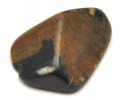Onyx, sard, and sardonyx are all varieties of the micro-crystalline quartz, chalcedony. All three varieties can be carved as small sculptures and intaglios, or may be polished, tumbled or cut as beads. They are renowned as excellent materials for inlay work.
- Onyx is similar to agate, but it has straight bands instead of curved. Bands may be brown and white or black and white.
- Sard is a brownish red variety, also similar to agate.
- Sardonyx, a mixture of sard and onyx, has the straight white bands of onyx and also the brownish red of sard.
Since Ancient Egyptian times, onyx has been stained to imporve or change its color. Much onyx has been produced by soaking agate in a sugar solution, then heating it in sulphuric acid to carbonize the sugar particles. Sard may be imitated by saturating chalcedony with an iron solution.
Found worldwide, they are formed by the decomposition of silica in gas cavities in lavas, which results in the distinctive bands.
Onyx seals were very popular with the Romans, who carved the pattern of the seal in negative relief to give a raised print. They often used stones with several layers, each of a different color, which were then individually carved to produce a different pattern in each layer.

































Leave a Reply
You must be logged in to post a comment.